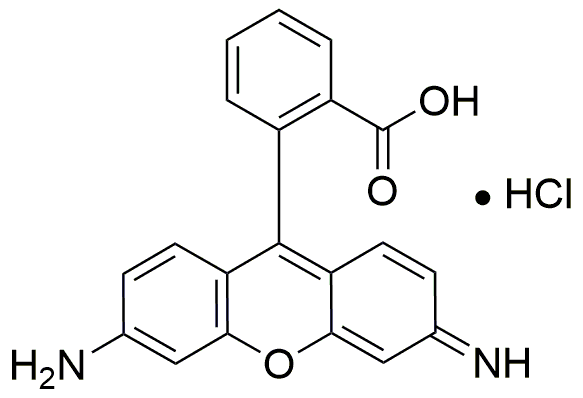Rhodamine 110 chloride is widely utilized in research focused on:
- Fluorescent Dyes: This compound is commonly used as a fluorescent dye in various biological and chemical assays, allowing researchers to visualize and track cellular processes under a fluorescence microscope.
- Environmental Monitoring: It serves as a tracer in hydrological studies to track water movement and contamination, helping environmental scientists assess the spread of pollutants in water bodies.
- Biochemical Research: Rhodamine 110 chloride is employed in studying enzyme activities and interactions, particularly in assays that require sensitive detection of biomolecules.
- Diagnostic Applications: In medical diagnostics, it is used in tests that require fluorescent labeling, aiding in the identification of specific proteins or pathogens in samples.
- Material Science: The compound is also applied in the development of new materials, particularly in creating fluorescent markers for polymers and nanomaterials, enhancing their functionality.
General Information
Properties
Safety and Regulations
Applications
Rhodamine 110 chloride is widely utilized in research focused on:
- Fluorescent Dyes: This compound is commonly used as a fluorescent dye in various biological and chemical assays, allowing researchers to visualize and track cellular processes under a fluorescence microscope.
- Environmental Monitoring: It serves as a tracer in hydrological studies to track water movement and contamination, helping environmental scientists assess the spread of pollutants in water bodies.
- Biochemical Research: Rhodamine 110 chloride is employed in studying enzyme activities and interactions, particularly in assays that require sensitive detection of biomolecules.
- Diagnostic Applications: In medical diagnostics, it is used in tests that require fluorescent labeling, aiding in the identification of specific proteins or pathogens in samples.
- Material Science: The compound is also applied in the development of new materials, particularly in creating fluorescent markers for polymers and nanomaterials, enhancing their functionality.
Documents
Safety Data Sheets (SDS)
The SDS provides comprehensive safety information on handling, storage, and disposal of the product.
Product Specification (PS)
The PS provides a comprehensive breakdown of the product’s properties, including chemical composition, physical state, purity, and storage requirements. It also details acceptable quality ranges and the product's intended applications.
Certificates of Analysis (COA)
Search for Certificates of Analysis (COA) by entering the products Lot Number. Lot and Batch Numbers can be found on a product’s label following the words ‘Lot’ or ‘Batch’.
*Catalog Number
*Lot Number
Certificates Of Origin (COO)
This COO confirms the country where the product was manufactured, and also details the materials and components used in it and whether it is derived from natural, synthetic, or other specific sources. This certificate may be required for customs, trade, and regulatory compliance.
*Catalog Number
*Lot Number
Safety Data Sheets (SDS)
The SDS provides comprehensive safety information on handling, storage, and disposal of the product.
DownloadProduct Specification (PS)
The PS provides a comprehensive breakdown of the product’s properties, including chemical composition, physical state, purity, and storage requirements. It also details acceptable quality ranges and the product's intended applications.
DownloadCertificates of Analysis (COA)
Search for Certificates of Analysis (COA) by entering the products Lot Number. Lot and Batch Numbers can be found on a product’s label following the words ‘Lot’ or ‘Batch’.
*Catalog Number
*Lot Number
Certificates Of Origin (COO)
This COO confirms the country where the product was manufactured, and also details the materials and components used in it and whether it is derived from natural, synthetic, or other specific sources. This certificate may be required for customs, trade, and regulatory compliance.


